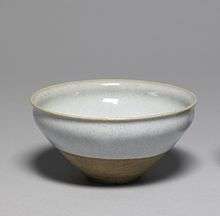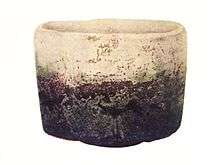Ofukei ware

Ofukei ware (御深井焼 Ofukei-yaki), also spelled Ofuke, refers to a type of Japanese pottery that was originally produced in Nagoya, central Japan.
History
During the Kan'ei era (1624-44), the first lord of Owari Tokugawa Yoshinao (1601–1650) had a kiln constructed at the corner of the Ofuke enceinte (Ofukemaru) of Nagoya Castle and invited potters from Seto to make pottery. Ofukei ware therefore has links to Seto ware. Production started around 1670 and was under the patronage of the Owari Tokugawa lords.[1]
Production initially focused on tea caddies (cha-ire), and tea bowls. The wares that came from the castle kiln were generally produced for the lords for their own use or as gifts.[2]
Ofukei ware however was also produced at a number of Mino ware kilns.[3] The production ceased in the Meiji era of the later half of the 19th century.
Ofuke ware is burned with the use of feldspar minerals and shows a transparent ash glaze. Wares came in all sorts of shapes and sizes.
References
- ↑ "Archived copy". Archived from the original on August 17, 2013. Retrieved March 16, 2016.御深井焼-454146
- ↑ http://www.asia.si.edu/collections/edan/object.php?q=fsg_F1901.119&bcrumb=true
- ↑ http://www.asia.si.edu/collections/edan/object.php?q=fsg_F1901.119&bcrumb=true
External links
![]() Media related to Ofukei ware at Wikimedia Commons
Media related to Ofukei ware at Wikimedia Commons
- Walter Art Museum | White tenmoku tea bowl Ofuke ware
- Freer Gallery of Art and Arthur M. Sackler Gallery | Ofuke wares
- Kagedo | Ofuke ware rabbit brazier
